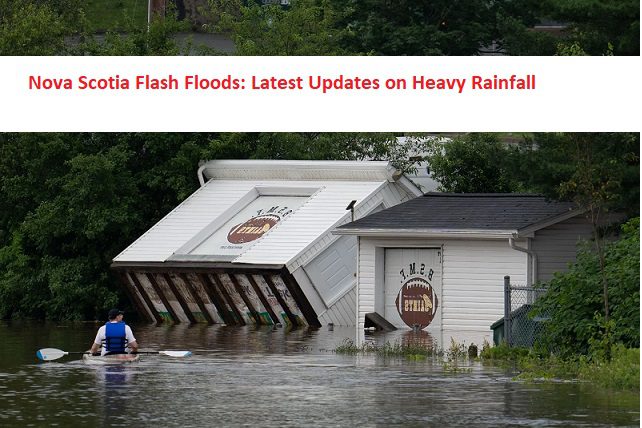Nova Scotia Flash Floods: Latest Updates on Heavy Rainfall
Halifax, Nova Scotia Thunderstorms have caused flash floods, road washouts, and power outages in Nova Scotia, Atlantic coast. As of Saturday morning, four people were missing due to the intense rainfall.
After their vehicle sank in West Hants, north of Nova Scotia, two adults and two children are missing, according to the RCMP. The children were lost when their vehicle sank. Other occupants escaped safely. Two people were rescued from another vehicle submersion, but a youth and a man were missing.
Since Friday afternoon, the region has been experiencing heavy rainfall, with some areas receiving over 200 millimeters, far above the July average of 90-100 mm. Based on radar estimates and unofficial observations, Environment Canada reported that some regions may have received more than 300 mm of rainfall in 24 hours. The heaviest rains have fallen on the southwestern shore and north of Nova Scotia.
Flooding has reached Lunenberg County west of Nova Scotia. Halifax Search and Rescue volunteers rescued people from flooded homes in Bedford on Friday night using small boats. Flooding destroyed driveways and road shoulders in northwest Hammonds Plains.
This is the same area where a wildfire destroyed 151 homes and businesses on May 28, forcing 16,000 residents to evacuate. A rare occurrence so close to the coast, Nova Scotia has had high humidity for much of the past week.


Mayor Mike Savage acknowledged the changing climate and its effects on Nova Scotia. Last fall, post-tropical storm Fiona hit the Atlantic region, killing three people, damaging property, and knocking out power to over 600,000 homes and businesses. Over 800 million Canadian dollars ($604 million) in insured damage was caused by Fiona, the region’s costliest weather event.
Mayor Savage noted that climate change is evident in Fiona, spring wildfires, and summer flooding. Storms that were once one-in-50-year events now occur more often, causing communities problems.
Although official records are yet to be updated, it is believed that Nova Scotia has not experienced this level of rainfall since August 16, 1971, when hurricane Beth made landfall near Nova Scotia’s eastern tip and wreaked havoc over Cape Breton. Flooding and damage occurred due to almost 250 mm of rain.
The communities affected by these extreme weather events are dealing with the aftermath while authorities and rescue teams search for the missing. The region must prepare for and mitigate such events as climate patterns become more unpredictable and extreme.
Our Reader’s Queries
What areas are affected by flooding in Nova Scotia?
Halifax, East Hants, West Hants, Lunenburg, and Queens municipalities and counties were hit hard by the floods, with some areas experiencing as much as 300 millimeters of rain.
How much rain did Nova Scotia get in 2023?
The latest data shows that the total rainfall for 2023 in the Halifax-Dartmouth area was between 650 to 740 mm. This includes measurements taken at Environment Canada’s Halifax Windsor Park site (728 mm) and Halifax Kootenay site (740 mm).
Are 4 people missing in the Nova Scotia flooding?
Two rescue missions are currently in progress in Nova Scotia to locate four individuals, including two minors, who are missing after the cars they were traveling in were engulfed by floodwaters in West Hants. During a press conference on Saturday, RCMP Cpl. provided updates on the situation.
Is it safe to travel to Halifax?
Halifax boasts lower crime rates compared to other big cities, but it’s still important to stay cautious. Be aware of your surroundings, avoid showing off expensive items, and think about using a trusted taxi service when out late at night for extra safety.

